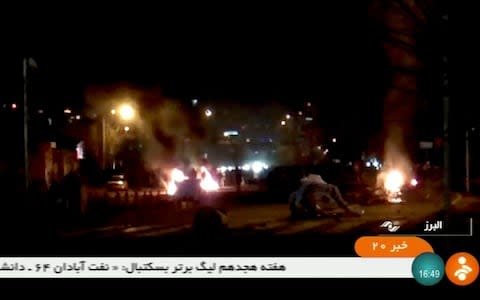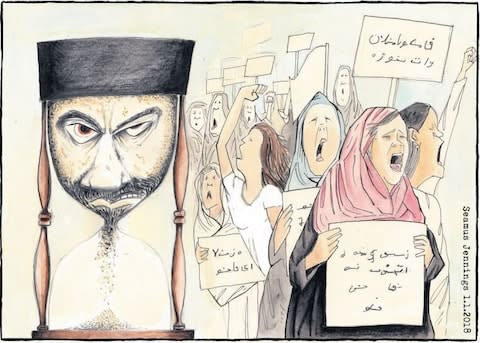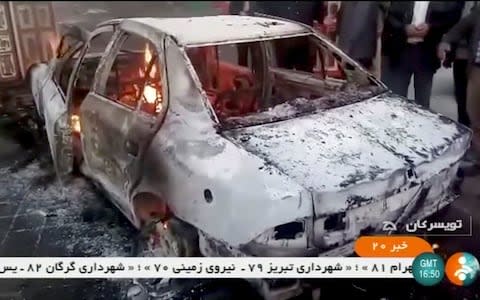Hundreds arrested as Ayatollah Ali Khamenei blames Iran's 'enemies' for unrest

The Iranian regime accused Britain, the US and Saudi Arabia of fomenting protests in the country as government forces struggled to contain the increasingly violent and widespread unrest.
In his first public comments since protests began six days ago, Iran’s supreme leader Ayatollah Khamenei blamed the uprising on the “enemies of Iran” and said foreign governments were sending money and weapons to undermine the Islamic Republic.
"The enemy is always looking for an opportunity and any crevice to infiltrate and strike the Iranian nation,” he said.
At least 21 people have been killed since last Thursday, including a police officer and a Revolutionary Guardsman, and the violence appeared to be intensifying as security forces fired on crowds and demonstrators attacked police stations.
While President Hassan Rouhani initially offered conciliatory words, saying the protesters had legitimate grievances over the state of the economy, the government’s stance has hardened in recent days.

The head of Tehran’s Revolutionary Court warned that protesters could face the death penalty if convicted of moharebeh, waging war against God, while state television said those arrested after the first 48 hours of demonstrations would be treated more severely.
Around 1,000 people have been arrested so far, authorities said.
Kellyanne Conway, Donald Trump’s senior advisor, said the White House was considering new sanctions on Iran in response to its crackdown on the protesters. The sanctions would likely take aim at the Revolutionary Guard, the regime’s elite forces which also control major business interests.
Ali Shamkhani, one of Iran’s top security officials, said that Britain, the US and Saudi Arabia were behind the protests and had generated many of the calls on social media for people to take to the streets.
"What is happening in Iran will be over in a few days, and there is no reason to worry at all," he said, according to Iran’s Press TV.
Protests in Iran - map
While the last major protests in 2009 were propelled by affluent Tehranis angry over disputed election results, the current wave of unrest is spread geographically across the country and many of the demonstrators are from the lower-middle and working classes.
“There is a growing consensus that the protests are comprised primarily of members of the working class, who are most vulnerable to chronic unemployment and a rises in the cost of living,” said Esfandyar Batmanghelidj, founder of the Bourse & Bazaar website, which tracks Iran's economy.
Many protesters said they had taken to the streets out of economic frustration and a sense that the economy was not improving even after the 2015 nuclear deal which eased sanctions on Iran.

“It is quite clearly against unemployment, poverty and the miserable life of the nation,” said one young man interviewed in an Iranian television report widely shared on social media.
Unemployment in Iran stands at more than 12 per cent while youth unemployment is at 29 per cent, according to the Statistical Centre of Iran.
Protests broke out in dozens of cities and towns across the country, with some of the most intense violence taking place in places that few Iranians had ever heard of.
Many said they needed to look up Qahderijan, a town of just 30,000 people, where six demonstrators were reportedly killed as a crowd tried to attack a police station.
“Whereas the [2009] Green Movement started in Tehran this is happening in smaller cities and towns, in places which may not have seen protests since 1979,” said Holly Dagres, editor of the Iranist newsletter.

The 2009 protests were also headed by two reformist presidential candidates, while the current demonstrations appear to be leaderless. Both candidates were eventually arrested and their detention helped to quell the demonstrations.
Analysts said the leaderless current protests could not be decapitated so easily but that without figureheads the movement would lack strategic direction and might die out of its own accord.
Security forces were deployed heavily in Tehran to try to prevent the capital from becoming a stage for widespread demonstrations. “It is as if the capital city has been occupied by a foreign army,” wrote Jaffar Panahi, one of Iran’s most famous film directors.

